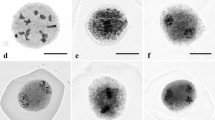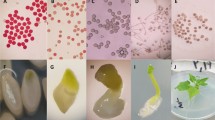Abstract
Eucommia ulmoides Oliver is an important temperate species because it contains Eucommia rubber, iridoids, and other medicinal substances. Triploid breeding may be an effective way to improve the contents of gutta percha and other secondary metabolites in Eucommia leaves. To obtain triploid trees, 2n female gametes were induced by exposing female buds to high temperatures. The results showed that although the Eucommia female flower bud development is not synchronous, it still exhibits regularity. We estimated the period of megaspore mother cell meiosis based on the number of days since the adjacent male flower produced its pollen.Using female buds at 1–4 days after pollination, we obtained triploid seedlings after female buds were treated with different temperatures and durations to induce megaspore chromosome doubling. Among the offspring, 23 of Eucommia triploid seedlings were detected. Our findings indicate that the most suitable condition for inducing megaspore chromosome doubling occurred at 3 days after adjacent male tree produce pollen when the meiosis of the megasporocytes was between pachytene and diplotene. The best treatment of 45 °C for 4 h gave triploid induction of 5.74 %.




Similar content being viewed by others
References
Bamba T, Fukusaki E, Nakazawa Y, Kobayashi A (2002) In situ chemical analyses of trans-polyisoprene by histochemical staining and Fourier transform infrared microspectroscopy in a rubber-producing plant, Eucommia ulmoides Oliver. Planta 215:934–939
Bingham ET (1980) Maximizing heterozygosity in autopolyploids. Basic Life Sci 13:471–489
Deng JY, Liu YF, Huang HW (2006) Development and characterization of microsatellite markers in Eucommia ulmoides Oliver (Eucommiaceae). Mol Ecol Notes 6:496–498
Deyama T, Nishibe S, Nakazawa Y (2001) Constituents and pharmacological effects of Eucommia and Siberian ginseng. Acta Pharmacol Sin 22:1057–1070
Dorsey E (1936) Induced polyploidy in wheat and rye. Chromosome doubling in triticum, secale and triticum-secale hybrids produced by temperature changes. J Hered 27:155–160
Du HY (1996) Eucommia ulmoides Silviculture. China Forestry Press, Beijing (in Chinese)
Du HY (2003) The progress in research of the active component from Eucommia ulmoides and its pharmacology. Nonwood For Res 21:58–61 (in Chinese with English abstract)
Eigsti OJ, Dustin PJ (1955) Colchicine in agriculture, medicine, biology and chemistry. Iowa State College Press, Ames
Einspahr DW (1984) Production and utilization of triploid hybrid aspen. Iowa State J Res 58(4):401–409
Evans WC (1989) Trease and evans pharmacognosy. English Language Book Society/Bailliere Tindal, London, pp 93–109
Galbraith DW, Harkins KR, Maddox JM, Ayres NM, Sharma DP, Firoozabady E (1983) Rapid flow cytometric analysis of the cell cycle in intact plant tissue. Science 220:1049–1051
Gao P. (2006) Gamete and zygote chromosome doubling of Eucommia ulmoides Oliv (in Chinese with English abstract)
Gao P, Lin W, Kang XY (2004) Pollen chromosome doubling of Eucommia ulmoides induced by colchicine. J Beijing For Univ 26:39–42 (in Chinese with English abstract)
Horii Y, Tanida M, Shen J, Hirata T, Kawamura N, Wada A, Nagai K (2010) Effects of Eucommia leafextracts on autonomic nerves, body temperature, lipolysis, food intake, and body weight. Neurosci Lett 479:181–186
Kang XY (2006) CN. Patent No. 200610113448.X Beijing, CN (in Chinese)
Kang XY, Zhu ZT, Lin HB (1999) Study on the effective treating period for pollen chromosome doubling of Populus Tomentosa × P.boleana. Sci Silvae Sin 4:21–24 (in Chinese with English abstract)
Kang XY, Zhu ZT, Zhang ZY (2000) Suitable period of high temperature treatment for 2n pollen of Populus tomentosa × P. bolleana. J Beijing For. Univ 22:1–4 (in Chinese with English abstract)
Kumar Das S, Sabhapondit S, Ahmed G, Das S (2013) Biochemical evaluation of triploid progenies of diploid 3 tetraploid breeding populations of Camellia for genotypes rich in catechin and caffeine. Biochem Genet 51:358–376
Li FD, Du HY (2001) Eucommia ulmoides Oliv. Chinese Medicine Press, Beijing, pp 232–234 (in Chinese)
Li YH, Ma J, Kang XY (2005) Stages of MMC meiosis and its timely discrimination of white Poplars. J Beijing For Univ 27(2):70–74
Li YH, Kang XY et al (2008) Triploid induction in Populus alba x P. glandulosa by chromosome doubling of female gametes. Silvae Genet 57:37–40
Lu M, Zhang PD, Kang XY (2013) Induction of 2n female gametes in Populus adenopoda maxim by high temperature exposure during female gametophyte development. Breed Sci 63:96–103
Mao YK (2012) Techniques of chromosome doubling of gamete of Eucommia ulmoides Oliv. induced by high temperature (in Chinese with English abstract)
Mashkina OS, Burdaeva LM, Belozerova MM, Vyunova LN (1989) Method of obtaining diploid pollen of woody species. Lesovedenie 1:19–25
Nilsson-Ehle H (1936) Note regarding the gigas form of Populus tremula found in nature. Hereditas 21:372–382
Randolph LF (1932) Some effects of high temperature on polyploidy and other variations in maize. Proc Natl Acad Sci USA 18:222–229
Tian LX, Li G (1994) The study on developing regulation of fruit of Eucommia ulmoides Oliv. J Northwest For Coll 9:1–7 (in Chinese with English abstract)
Tian LX, Yan H (1983) The stuy on developing process of embryo in Eucommia ulmoides Oliv. J Wuhan Bot Res 11:205–210 (in Chinese with English abstract)
Van Buijtenen JP, Joranson PN, Einspahr DW (1958) Diploid versus triploid aspen as pulpwood sources with reference to growth, chemical, physical and pulping differences. Tappi 41:170–175
Wang YH (2006) Studies on polyploid induction of Eucommia ulmoides olive. Asia-Pacific Tradit Med 8:73–76 (in Chinese with English abstract)
Wang J, Li DL, Kang XY (2012) Induction of unreduced megaspores with high temperature during megasporogenesis in Populus. Ann For Sci 15:1–9
Yan RF (2007) Insight into materials engineering of Eucommia ulmoides gum. Int Symp Eucommia Ulmoides 1(1):34–37
Yan RF (2010) Development and application of Eucommia rubber. China Rubber Sci Technol Mark 8:9–13 (in Chinese with English abstract)
Yao XH, Deng JY, Huang HW (2012) Genetic diversity in Eucommia ulmoides (Eucommiaceae), an endangered traditional Chinese medicinal plant. Conserv Genet 13:1499–1507
Zhang L. (2010) Studies on Pollen chromosome doubling technique of Eucommia ulmoides Oliv. by high temperature induction (in Chinese with English abstract)
Zhang JC, Xue ZH (2011) A comparative study on the properties of Eucommia ulmoides gum and synthetic trans-1,4-polyisoprene. Polym Test 30:753–759
Zhang XZ, Liu GJ, Yan LY et al (2003) Creating triploid germplasm via induced 2n pollen in Capsicum annuum L. J Hortic Sci Biotech 78(1):84–88
Zhang HF, Guo BL, Zhang CG, Yang JX, Guo J, Chen XH (2008) Induction and identification of tetraploids in Eucommia ulmoides olive. Acta Hortic Sin 35:1047–1052 (in Chinese with English abstract)
Zhu DY, Tian HQ, Jiang JH, Gu WY, Wang M, Zhu M, Mi JJ, Li JM (1998a) Callus induction and plant regeneration from dry mature endosperm dultures of Eucommia ulmoides Oliv. J Agric Biotechnol 6:307–312 (in Chinese with English abstract)
Zhu ZT, Kang XY, Zhang ZY (1998b) Studies on selection of natural triploids of Populus tomentosa. Sci Silave Sin 34(4):22–31
Acknowledgments
We thank Dr. Pingdong Zhang from Beijing Forestry University for additional help. This research was financially Supported by Beijing Natural Science Foundation (5141001).
Author information
Authors and Affiliations
Corresponding author
Rights and permissions
About this article
Cite this article
Li, Y., Wang, Y., Wang, P. et al. Induction of unreduced megaspores in Eucommia ulmoides by high temperature treatment during megasporogenesis. Euphytica 212, 515–524 (2016). https://doi.org/10.1007/s10681-016-1781-4
Received:
Accepted:
Published:
Issue Date:
DOI: https://doi.org/10.1007/s10681-016-1781-4




